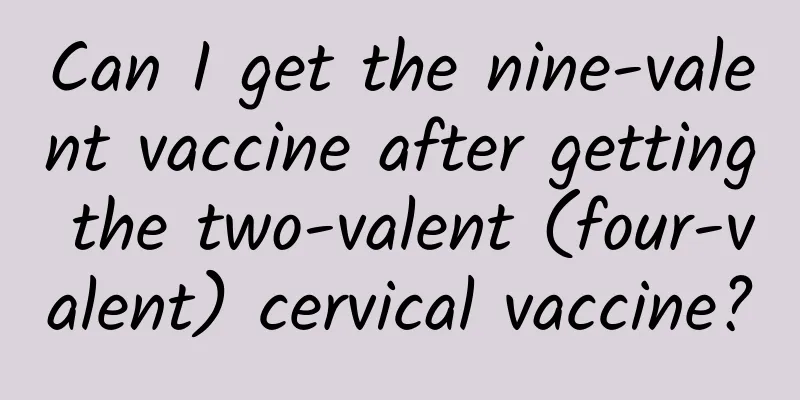Can I get the nine-valent vaccine after getting the two-valent (four-valent) cervical vaccine?

|
1. The difference between bivalent, quadrivalent and nine-valent cervical vaccines There are three common vaccines for preventing cervical cancer: bivalent, quadrivalent and nine-valent. The biggest difference between the three vaccines is the types of HPV (human papillomavirus) they can prevent, the age range they are suitable for and the protective effect. 1. Prevention of different HPV types: The bivalent vaccine mainly targets two high-risk viruses, HPV16 and 18, which are the main causes of about 70% of cervical cancer cases worldwide. The quadrivalent vaccine adds prevention of HPV6 and 11 on the basis of the bivalent vaccine. These two viruses mainly cause genital warts. The nine-valent vaccine further expands the scope of prevention, covering nine types of viruses including HPV16, 18, 6, and 11. These viruses are not only related to cervical cancer, but also to vaginal cancer, anal cancer, vulvar cancer, laryngeal cancer, oral cancer and other cancers and diseases. 2. The applicable age groups are different: Generally, the bivalent vaccine is mainly for women aged 9 to 45, the quadrivalent vaccine is more suitable for women aged 20 to 45, and the nine-valent vaccine is more suitable for women aged 16 to 26. However, these age ranges may vary slightly between different regions and different products. It is best to consult a local medical institution or professional doctor before vaccination. 3. Different protection effects: Since the nine-valent vaccine covers the most HPV types, it provides the most comprehensive protection. The nine-valent vaccine can prevent about 90% of cervical cancer, 90% of genital warts, 85% of vaginal cancer, 95% of anal cancer, etc. The two-valent vaccine can prevent about 70% of cervical cancer, while the four-valent vaccine can prevent about 90% of genital warts in addition to cervical cancer [1]. 2. Can I get the nine-valent vaccine after getting the two-valent (four-valent) cervical vaccine? Many women are concerned about this. It is important to understand that after receiving the bivalent or quadrivalent vaccine, theoretically, they can receive the nine-valent vaccine. However, whether such repeated vaccinations are necessary in practice depends on personal circumstances and the advice of professional doctors [2]. If you have received the bivalent or quadrivalent vaccine and achieved the corresponding protective effect, it is not necessary to receive the nine-valent vaccine. This is because the bivalent and quadrivalent vaccines have already provided effective protection against high-risk HPV viruses, and although the nine-valent vaccine can prevent more types of HPV, it does not mean that it can completely replace the first two vaccines. The nine-valent HPV vaccine prevents HPV types 6, 11, 16, 18, 31, 33, 45, 52, and 5.8. In addition to preventing types 16 and 18 covered by the two-valent vaccine, the nine-valent vaccine also adds several other high-risk types (31, 33, 45, 52). There are many factors to consider before determining whether to vaccinate with the nine-valent vaccine: 1. Age factors. The nine-valent vaccine has a clear age range, and vaccination at the appropriate age must be ensured. 2. Health status and reactions after previous vaccinations. If there are any doubts or discomfort, consult a professional doctor in time. In addition, since the nine-valent vaccine is relatively expensive, vaccination must be carried out at a certain time interval, so economic factors and time costs must also be considered. To determine whether to repeat the vaccination, it is advisable to consult a professional doctor or medical institution. A comprehensive assessment can be conducted based on multiple factors such as the individual's age, health status, reactions after previous vaccinations, and economic strength, and the most appropriate recommendations can be made accordingly. If you decide to receive the nine-valent vaccine, you need to ensure that there is a sufficient interval between the last vaccine and the vaccination, and follow the doctor's instructions. After the vaccination, you still need to maintain good living habits and screen for cervical cancer regularly to detect and respond to various possible problems early. In summary, cervical 2, 4, and 9-valent vaccines have a good preventive effect on cervical cancer. When choosing a vaccine and vaccination plan, you should consider your personal situation and the advice of a professional doctor. No matter what vaccine you take, it is impossible to completely eliminate HPV infection, so you also need to have good living habits and regularly screen for cervical cancer. 3. How to choose a vaccine Many women may have doubts about the choice of cervical vaccine. After all, there are three different vaccines on the market for you to choose from: bivalent, quadrivalent, and nine-valent. Women should consider the following key factors when making a decision. When choosing a vaccine, the first thing to consider is age. Different vaccines have different applicable age ranges. Generally speaking, the bivalent vaccine is suitable for women aged 9 to 45, the quadrivalent vaccine is suitable for women aged 20 to 45, and the nine-valent vaccine is mainly suitable for women aged 16 to 26. However, there are slight differences in the above age ranges for different regions and different products. Therefore, when choosing a vaccine, women should first confirm that their age is consistent with the applicable range of the selected vaccine. When choosing a vaccine, women should consider their prevention needs and expectations. The bivalent vaccine targets two high-risk types of HPV, HPV16 and HPV18, and provides basic protection against cervical cancer. The quadrivalent vaccine is based on the bivalent vaccine and adds HPV6 and HPV11 vaccines, which mainly cause genital warts. The nine-valent vaccine provides the most comprehensive protection, covering nine types of HPV associated with cervical cancer and other related cancers. So if women want more comprehensive protection, the nine-valent vaccine may be a better option. But if women are mainly concerned about preventing cervical cancer, and are limited by age, economic factors, etc., then the bivalent or quadrivalent vaccine are both good options [3]. When choosing a vaccine, the price of the vaccine should also be considered. The nine-valent vaccine is relatively expensive, while the two-valent and four-valent vaccines are cheaper. Women should choose the appropriate vaccine according to their economic situation and budget. If economic conditions permit and women want to get the most adequate protection, the nine-valent vaccine may be the first choice. However, if economic conditions are limited, women can choose the two-valent and four-valent vaccines, which can also provide effective protection. When choosing a vaccine, women should also consider vaccination schedules and convenience. Different vaccines require different vaccination schedules and timetables. Some vaccines may need to be administered multiple times, while others only need to be administered once. In addition, different vaccines may be administered at different locations and times. Therefore, when choosing a vaccine, women should understand the selected vaccination schedule and requirements to ensure that they can be administered on time. References [1] Chen Xi. Can people who have received the bivalent and quadrivalent vaccines still receive the nine-valent vaccine? [J]. Family Life Guide, 2023(1):66-66. [2] Ye Yubing, Li Bo. Understanding human papillomavirus vaccine[J]. Kaijuanyi-Seeking Medical Advice, 2024(06):43-44. [3] Liu Mulan. How to choose HPV bivalent, quadrivalent, and nine-valent vaccines for women[J]. Renrenjian. Disclaimer: The pictures in this article are from the Internet |
<<: A complete guide to preoperative preparation
>>: Sugar-free foods do not contain sugar, can diabetics eat them at will?
Recommend
Can I apply Sanfu plaster when I have my period?
The Sanfu weather is actually very suitable for r...
Does diarrhea in early pregnancy affect the fetus?
If pregnant women have diarrhea in the early stag...
What should I do when my wife has her period?
Most men think that menstruation is a female matt...
Reasons for brown discharge after menstruation
We all know that after the menstruation ends, wom...
Igm is normal and igg is very high
Often when some female friends go for a physical ...
Member Sima Hong: Proposal on improving the scientific literacy of my country's elderly
According to data released by the National Bureau...
What are the causes of vaginal wall prolapse?
The vagina is an important reproductive organ of ...
What is the cause of breast numbness?
There are many female friends who suffer from bre...
Female hands numb when sleeping at night
When sleeping at night, the body should be in a s...
Pathological secrets: the "golden key to diagnosis" of childhood neuroblastoma
Author: Zou Jizhen, Chief Physician, Children'...
Drink less colored drinks, studies have found that two common food dyes may induce or aggravate colitis!
Intestinal damage, such as physical stimulation, ...
She was in surgery, her blood pressure dropped, the doctor found the culprit
A few days ago, an orthopedic surgery once again ...
Can I eat spicy food when I am pregnant?
You can eat spicy chips during pregnancy, but you...
What should I pay attention to during sex after a normal delivery and episiotomy?
Many women will take nutritional supplements duri...
Does neck pain require massage?
In modern society, due to the widespread use of c...









